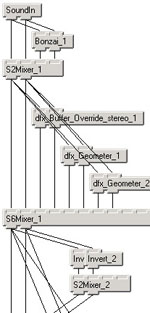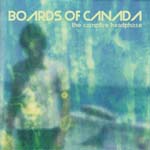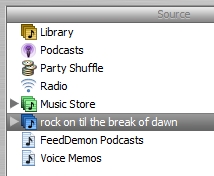Composting waveforms

My interest in Four Tet led me to a novel application he uses called AudioMulch. In a nutshell this program allows you to build a visual diagram of how your sound sources will flow, enabling what the developers call “an analog approach to electronic music.” The main window allows the composer to stitch together “contraptions” — basically nodes that either input, output, or modify sound — to create a kind of sound machine that can be tweaked entirely visually. The interface is fascinating (not unlike the video processor GraphEdit, which I mused on so long ago) and gets you creating interesting sounds immediately. The tool is powerful, too, permitting layering and full sequencing. And the potential for creating visually interesting networks of contraptions (beautiful in their own right) that also create cool music is really appealing. I’ll work on that.
Set it to purée
“Now the making of a good compilation tape is a very subtle art. Many do’s and don’t’s. First of all you’re using someone else’s poetry to express how you feel. This is a very delicate thing.” – Rob Gordon, High Fidelity
What’s more fun than making a music mix? Making it via e-mail with friends, of course — especially friends with extremely different musical perspectives. So we did. The rules of the game were that we would rotate theme selection and then pick songs one after another. You didn’t have to defend your selection (though some of them begged defense) but each person got one veto per mix. After looking at these mixes I’m sure you wish you had a few too.

Guilty!
The Top 15 Choons You Will Rock Out To Till The Day You Die.
(but won’t admit publicly…until now)
- Unbelievable – EMF (Unbelievable [single], 1990)
- The Stroke – Billy Squier (Don’t Say No, 1990)
- Night Fever – Bee Gees (Saturday Night Fever: The Original Movie Soundtrack, 1977)
- Fire It Up – Busta Ryhmes (Turn It Up/Fire It Up [single], 1998)
- The Devil Went Down To Georgia – The Charlie Daniels Band (Million Mile Reflections, 1979)
- Parents Just Don’t Understand – DJ Jazzy Jeff and the Fresh Prince (He’s the DJ, I’m the Rapper, 1988)
- Here I Go Again – Whitesnake (Whitesnake, 1987)
- Love Machine – Girls Aloud (What Will The Neighbours Say?, 2004)
- Man! I Feel Like a Woman – Shania Twain (Come on Over, 1997)
- Rock Your Body – Justin Timberlake [Sander K retouch] (Rock Your Body (single), 2003)
- America – Neil Diamond (The Jazz Singer [soundtrack], 1980)
- I Wanna Be Your Lover – Prince (Prince (s/t), 1979)
- Billie Jean – Michael Jackson (Thriller, 1982)
- Jesus Built My Hotrod [Redline/Whiteline version] (Jesus Built My Hotrod [single], 1991)
- Jane – Jefferson Starship (Freedom at Point Zero, 1979)

Musical Meds
Songs that can make your mood do a 180°
- Hazy Shade of Winter – Bangles (Less Than Zero [soundtrack], 1987)
- Sixyten – Boards of Canada (Music Has The Right to Children, 1997)
- Electric Avenue – Eddy Grant (Electric Avenue [single], 1981)
- Oblivious – Aztec Camera (High Land, Hard Rain, 1983)
- Sexuality – Billy Bragg (Don’t Try This At Home, 1991)
- Gorecki – Lamb (Lamb [s/t], 1996)
- Uncertain Smile – The The (Soul Mining, 1983)
- Love Song – The Ocean Blue (The Ocean Blue [s/t], 1989)
- The Same Deep Water As You – The Cure (Disintegration, 1989)
- In the Garden / You Send Me / Allegheny – Van Morrison (A Night in San Francisco, 1994)
- Impact (The Earth is Burning) – Orbital (Orbital 2 [The Brown Album], 1993)
- Song 2 – Blur (Blur [s/t], 1997)
- Add It Up – Violent Femmes (Violent Femmes [s/t], 1983)
- Last Night I Dreamt That Somebody Loved Me – The Smiths (Strangeways, Here We Come, 1990)
- It’s The End Of The World As We Know It (And I Feel Fine) – R.E.M. (Document, 1987)
Agree, disagree? Discuss.
Tale of two online music stores
I’ve been known to buy music from iTunes Music Store. What’s that, you say? Why buy from iTMS when the Russian sites offer the same tunes for a fraction of the price? In part, I like the pay-for-what-you-buy mode better than the give-us-a-bunch-of-money-upfront-and-then-we’ll-debit-per-track mode. Something is just a tad slimy about that. Even so, there’s really only one reason I buy from iTMS and that is JHymn, the program that immediately and easily allows me to rip the crappy digital rights management out of the files. If I bought it I want to be able to play it whenever, wherever, and on as many machines as I damn well please.
But this isn’t an iTunes screed. I’d like to make a simple comparison between iTMS and the other music store I use a lot, Bleep.com.
| iTunes Music Store | Bleep.com | ||
| unencrypted music | no | yes | |
| web-based | no | yes | |
| playable on all devices | no | yes | |
| full song preview | no | yes | |
| zipped download of multiple files | no | yes | |
| reviewer bias in comparison | yes | yes |
I’m not sure these factors matter to the average online music buyer, but I wonder how long iTMS can stay dominant. Sooner or later the casual music buyer will figure out the problems in the iTMS model. In fact, I know a few people who just want to make mixes for their friends — for instance, as party favors — and have no idea why they can’t do so with their iTMS-restricted files. Something’s gotta give.
OK, maybe it was an iTMS screed.
Drop the needle

I couldn’t wait for the CD so I purchased the new Biosphere album Dropsonde in vinyl, my first record purchase in four years or so. Coming on the heels of my recent Boards of Canada fake-track debacle (only possible in these digital music-obsessed days) it was a completely enjoyable, material experience. I was instantly in grade school again, fetishizing the platter and poring over the cover art as if I held a Rembrandt in my hands. Of course I immediately digitized it and have embarked on the daunting — though so pleasingly nostalgic — task of doing the same for all the 33’s and 45’s that I do not own digitally. On some of the records I actually remember every scratch and hiss as if they were part of the original recording.
Ways in which vinyl is better than bits:
– Imperfections in the vinyl, especially those caused by the owner (needle dropped too hard, flattening of the grooves from overplay, etc.) make that album more personal, indelibly stamping it as unique and yours-alone. Call it analog watermarking.
– At a glance you can instantly see the relative durations of all the songs on a side. Sorta like the advantage of an analog watch. You only need spatial awareness to see that you have a quarter of a circle’s worth of time before your meeting.
– Perfectly hitting the blank grooves between songs with the stylus is damn satisfying.
– Cover art, cover art, cover art. Bigger, badder, bolder.
And the album Dropsonde? It is as good as they say. Geir appears to be infatuated with jazz percussion. The minimalism of Autour de la Lune is gone and occasionally a higher-range line (“melody” would be imprecise) takes over in a way reminiscent of his older work. Highly recommended.
When the original just won’t do
So what happens when you find out that an album you downloaded illegally because you were so anxious to have it that you broke a longstanding pledge not to deal with sketchy P2P networks and with every intent of actually buying the album when it was released — hang on, let me catch my breath — OK, so what happens when you do buy the album legally and you find out that five of the tracks on the album are fake, or maybe not fake but certainly not from this album if they are in fact by the same artist at all and that you in fact like those tracks better than the legitimate tracks (of the same name!) on the officially released album? What happens then, I ask!? You’re in a real pickle, I’ll tell you.
You know by now that I really love the new Boards of Canada album. 10 of the 15 tracks I had downloaded are identical, so it is safe to say that 66% of it my initial reaction is unqualified. But the other five tracks — they are so typically Boards of Canada and fit in so well musically that I am almost incapable of admitting what is obvious. Someone — maybe BoC themselves — released a bogus copy of the album on filesharing networks. Yet, two-thirds of the tracks were legit. And the non-legit ones might as well have been from the same band they are so musically identical.
There’s raging debate over whether these tracks are from another band or from early BoC — and in fact there appear to be different bogus albums out there — but the point is that I fell in love with an album that was musically holistic, but which I now know to be not what the artists’ intended. But, truly, the “fake” tracks make a better album.
This is like falling in love with the cover of a song before ever knowing the original and not liking the original when you finally hear it.
Bad John, bad. Filesharing bad!
Brothers in knob-twiddling
Mike and Marcus of Boards of Canada recently gave a great interview to Pitchfork where they revealed that there is an unreleased acoustic version of Music Has The Right To Children and — after an off-the-record pause to debate the point — admitted that they are, in fact, brothers. The reason for not publicly admitting it? They wanted to avoid comparisons to Orbital, another fraternal British electronica band — one that happens to occupy the same stratum of respect that I have for BoC.
So that got me wondering. Is there something about a brotherly relationship that leads to exceptional musical collaboration? Certainly there are many bands composed of family members, but specifically two brothers?
I’m not convinced this isn’t coincidence, but perhaps — perhaps — this has to do with the bedroom-studio nature of electronic music. That is, like most electronic music neither bands’ music requires elaborate studio setups or live recording. It is compact, home-brewed, and easily something that you’d be able to yell “hey, brother, come listen to this!” from the other room. This, as opposed to the rock band evolutionary culture that normally includes rockin’ out in a friend’s garage or at a party down the block. It’s less conducive to experimentation in the home and, maybe, less conducive to collaboration between brothers.
Who knows?
Gather ’round the Campfire
Boards of Canada essentially screwed their career with their first album, Music Has The Right To Children, by creating a musical singularity, something that by definition could not be followed by anything that could elicit the listener response that it did. Universally praised, MHTRTC sounded like nothing that preceded it and little that has come since. It was a once-per-decade work that made you simply stare jaw-agape at whatever you were playing it on — stereo, computer, portable, whatever. It isn’t often that music astonishes, but this album did — and does. We wished them luck with future releases.
Peel Sessions, an EP, some remixes, a new track here and there for a compilation, a reissue of a limited release pre-first album (which was damn good) and then their second album-length effort, Geogaddi. This was a great album, better by far than most band’s first. But it was the just-attractive sister of a supermodel. Laudable, but.
So in comes album three, The Campfire Headphase. Still cursed by their first, BoC comes damn close to being reborn virgins on this one. It is a great album. Buy it when it comes out — in lieu of the P2P tracks you already have (like me). There’s more structure, more 4/4, but none of this seems to compromise their style.
BoC have discovered the guitar. This is not as problematic as you would think. Their classic detuned loveliness infects the strings too and is well-integrated. Three clustered tracks are the core of this album. Satellite Anthem Icarus is choice ambient material (not unlike recent Mr. Projectile). Peacock Tail is the standout track, happy and eerie like a stoned clown. And the deep echo on the bass after the rhythm literally falls to pieces is just powerful. Dayvan Cowboy is the soundtrack-worthy selection. It evokes late-Orbital sweepingness and drama that you’d never find in earlier work, but it achieves what it shoots for.
Enough already. This is good stuff. Get it if you can.
Audiophile
Here are the characteristics of my perfect digital music file format. Would someone please invent? Note that most of these are not compression type specific. It stands to reason that much of this functionality could be included in new ID3 specs and/or extensions to the MP3 file type.
– Robust metadata, at least equivalent to current ID3 spec plus ability to embed dynamically updatable rating data (good idea, Greer!), links to websites, and machine-readable score data for classical pieces.
– Artwork support for multiple files (images or rich media) including the ability to reference an external file or the embedded artwork of another audio file. For instance, it would save hundreds of MB of file space if you could have a single file on an album contain the artwork for all the tracks on the album.
– Ability to recall point at which the file was last played (bookmarkable), like an m4b file.
– Ability to designate (or not) totally gapless continuous play for a selection of tracks (normally an album).
– File type that is essentially a pointer or shortcut. An application of this would be to allow you to delete two of the three identical versions of, say, How Soon Is Now? because it exists on Meat is Murder, Hatful of Hollow and the Smiths Greatest Hits. The track could live at one place but be included as an alias in the other. When copying the albums with shortcuts the system would offer you the ability to copy the full track or just the pointer. (Would do the same for the externally-referenced artwork in the idea above.)
– Variable compression including lossless. Same file format, just different compression schemes.
– No DRM of any kind.
LAN party
Sometimes a shared music library pops up from somewhere on your LAN segment and it becomes your mission to hunt down its owner.
An example. This library comes from someone who uses “party” as a verb. A lot.
But which co-worker?
Rock music

Permit another Biosphere post, won’t you? This is too good to pass up. The Isle of Skye in Scotland, formerly known to me merely as the home of a single kind of scotch, is the site of major new environmental art installation scored by Geir Jenssen of Biosphere fame. Quite possibly the opposite of sensory deprivation as you hike your way through the multimediated terrain, The Storr: Unfolding Landscape runs through Sept. 17.
Equipped with headlamps, guides and walking sticks, the audience takes a three and half kilometre, at times strenuous, walk which will take up to two hours to complete. They will witness one of Europe’s most dramatic and inspiring landscapes at night, whilst nva create an immense landscape work, lowing among the unique geological features. A specially developed new ‘Hansel and Gretel’ reflective light network will create a path through the beautifully lit rock formations. Contemporary sounds from the Norwegian composer Geir Jenssen, based in Tromso, and the voice of Skye’s legendary poet, Sorley MacLean, along with live song will drift down from the mountainside, creating an intense and personal experience for each walker. [More]
Much has been written about the musical echos of the sparse arctic landscape of Jenssen’s native Norway. And this isn’t his first use of a remote locale for his work. But the otherworldly natural formations, speciality lighting, and intergrated Scottish poetry suggest a truly unique experience.
I gotta get to Scotland.















